The Top 7 Time Management Theories Tested & Reviewed
It is not that we have a short space of time, but that we waste much of it,
Stoic philosopher: Seneca – “On the Shortness of life”
The above quote may have been written nearly 2,000 thousand years ago, but it rings true today. The average office worker puts in an eight-hour day but is only productive for about three hours of it, while business owners waste 21.8 hours of their week.
What is the secret to better time management? Is there a best theory or strategy to optimize our days? In pursuit of the answer, I decided to test and review the most popular time management theories and methods to find out which one made me the most productive.
The Experiment
For an entire week, I dedicated one day to each of the seven most popular time management theories and methods. During my experiment, I used the following apps:
Since I’m a writer, I measured productivity by:
- Number of words written per day
- Quality of words as judged by the Grammarly app (highest score is 100)
- Number of article drafts completed
- Number of Serene hours
- Number of Serene sessions completed
- Percentage of tasks completed
7 Theories Reviewed
1. The Pomodoro Technique
Developed by consultant Francesco Cirillo, the Pomodoro Technique is a time management tool that breaks work into 25-minute sessions to help you stay focused and get more done.
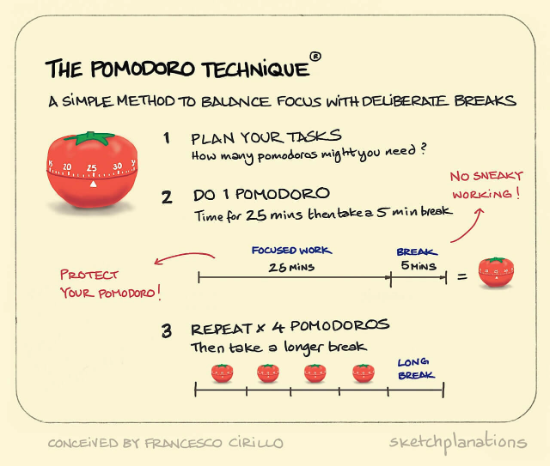
Here’s how it works:
| Step 1 | Choose a task |
| Step 2 | Set a timer for 25 minutes |
| Step 3 | Work on the task until the timer goes off |
| Step 4 | Once the timer goes off. Check off the item on a piece of paper |
| Step 5 | Take a short break |
| Step 6 | Every four Pomodoros, take a longer break |
Day 1 – Pomodoro Technique Experiment Results
- Number of words written: 1,381
- Grammarly score out of 100: Blog post #1: 94. Blog post #2: 95.
- Number of article drafts completed: 1
- Number of Pomodoro hours: 3 hours, 19 minutes
- Words per hour: 416
- Number of Pomodoros completed: Almost 9 (by the ninth Pomodoro, I only had the energy to work for 20 minutes).
- Percentage of tasks completed: Almost 100%
Using the Pomodoro Technique felt helpful, but rigid at times. I found myself hesitant to start work at all if I knew I wouldn’t be able to go 25 minutes without breaking away from the work. I also found a 5-minute break between Pomodoros was way too short and restrictive, so I didn’t time the breaks, but I probably went 10 to 15 minutes on short ones. For the longer breaks, I took about an hour.

I liked how the Pomodoro Technique forced me to focus entirely on the task at hand for the full 25 minutes. It made me much less likely to get distracted or switch tasks and work on something else.
Because I hate the sound of alarms, I revised this part of the Pomodoro method. I ended up simply using Toggl and checking the time repeatedly, which probably was bad as that could count as a distraction. I prefer to use Serene when I’m working, but since the app doesn’t have a setting for 25-minute sessions, I thought I had to use something else to remain faithful to the Pomodoro Technique. But I later found out that you don’t have to stick to 25-minute increments. You can do 20 minutes or even one hour. The Pomodoro Technique doesn’t have to be so restrictive; you can modify it however you like.
To get the most out of the Pomodoro Technique, I recommend planning your day ahead of time and breaking tasks into Pomodoros. I did this in a journal. Checking off the completed tasks on a piece of paper felt satisfying. Overall, I loved this method and will continue to use it.
2. The Pickle Jar Theory
The Pickle Jar Theory uses a metaphor to illustrate an essential point of time management: You must do the most important tasks first; otherwise, you’ll never get around to them.

Here’s the metaphor: Imagine that on a table before you, you have an empty pickle jar, some rocks, some pebbles, and some sand.
- The jar represents your time.
- The rocks represent the important tasks.
- The pebbles are less important tasks.
- The grains of sand are the unimportant tasks that pop up throughout your day, such as sending a text message, checking your email, or answering a phone call.
Now, knowing that your time is limited to what can fit inside the pickle jar, which items do you place in it first? If you pour all the sand in, add the pebbles, and then try to squeeze in the rocks last—you won’t have enough space for the rocks. But if you add the biggest items first (the rocks), then add the pebbles, and then pour the sand in, you’ll find that you had just enough space for the essential items.
So for the Pickle Jar Theory, you plan your day by deciding which tasks are your rocks, pebbles, and sand, and then you finish the rocks before moving on to anything else.
Day 2 – Pickle Jar Theory Experiment Results
- Number of words written: 1,363
- Grammarly score out of 100: Blog post: 93, Copywriting: 99
- Number of article drafts completed: 1 out of 2
- Number of hours worked: 4 hours, 17 minutes
- Words per hour: 318
- Number of Serene sessions completed: 6 (I didn’t use Serene for the first rock of the day, which took about 1 hour and 17 minutes)
- Percentage of tasks completed: 2.9 out of 3 rocks
The Pickle Jar Theory helped me gain a lot of progress on my most important tasks. While I was very tempted to move on to other projects that I had defined as pebbles, because I knew I had to complete the rocks first (so I wouldn’t run out of time to finish them), I didn’t stray from the major tasks at hand. Without that, I probably would’ve gone to work on other projects I deemed more fun than the rocks.
I woke up unusually early at 4 a.m. to complete the first rock of the day (writing website copy). What’s amazing is how much longer my focused work sessions were since it was the very first task of the day. My energy and focus tend to deplete as the day wears on—yet another reason to tackle the rocks first.
3. Parkinson’s Law
Parkinson’s Law, created by British naval historian and author Cyril Northcote Parkinson, states that “work expands so as to fill the time available for its completion.” And there’s plenty of proof that’s true. For example, at Microsoft Japan, cutting back to a four-day workweek and limiting meetings to 30 minutes boosted productivity by 40%.
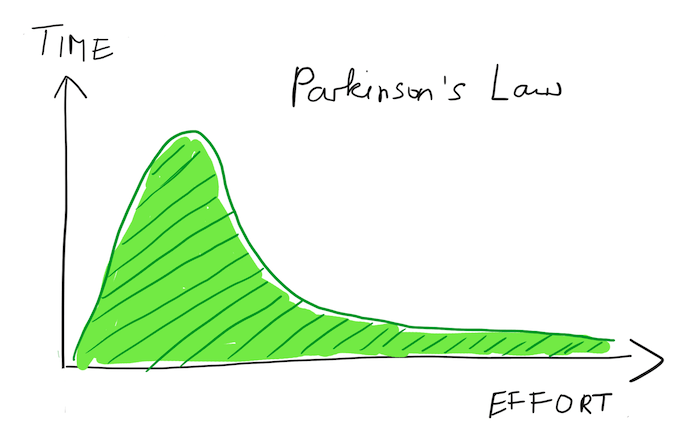
If Parkinson’s Law holds true, I should, theoretically, be able to write an article in less time than the previous article of the same length and kind.
Day 3 – Parkinson’s Law Experiment Results
- Number of words written: 3,294
- Grammarly score out of 100: Blog post # 1: 99, Blog post #2: 100
- Number of article drafts completed: 2 (both were due that day)
- Number of hours worked: 4 hours
- Words per hour: 823.5
- Number of Serene sessions completed: 12
- Percentage of tasks completed: 100
I was crazy productive today! Though I typically work in sessions of 25 to 30 minutes, for the Parkinson’s Law experiment, I cut that down to 20 minutes to see how much faster I could write when my time was limited.
Amazingly, I was able to write more words in 20 minutes than I did in 30 minutes. I think it’s because I knew I was trying to beat the clock. On top of that, I wrote an article in record time for one client; an article that typically takes me anywhere from three and a half to five hours took me only one hour and forty minutes by applying Parkinson’s Law.
It’s worth noting that both of these articles were due today, so there was extra time pressure to get them done faster than usual. I’m a big believer in Parkinson’s Law now.
4. The ALPEN Method
Developed by German economist Lothar J. Seiwert, the ALPEN method’s name is an acronym for German words, but here’s how it works:
| Step 1 | Create a to-do list before you begin the day |
| Step 2 | Estimate how long each item will take you |
| Step 3 | Allow 40% as “buffer time” – Things such as breaks & little tasks |
| Step 4 | Prioritize each task and delegate where you can |
| Step 5 | Take notes during the day & check off items as they’re completed |
| Move any uncompleted items to the next day |
Day 4 – ALPEN Method Experiment Results
- Number of words written: 1,949
- Grammarly score out of 100: Blog post: 93, Copywriting: 99
- Number of article drafts completed: Zero (nothing due today)
- Number of hours worked: 3 hours, 40 minutes
- Words per hour: 531
- Number of Serene sessions completed: 9 sessions
- Percentage of tasks completed: All of the important 60% tasks (the tasks I deemed as non-buffer)
I liked the ALPEN method! I was surprised by how accurate the work-buffer time split ended up being. I underestimated how long the first task would take me; it took me three times longer than I predicted. But in the end, I still checked off all the items on my list that were essential, and I didn’t even need as much buffer time as I had expected.
I also really liked having a checklist and checking off each item as I went. Allotting a set amount of time for each item forced me to stay on task and try to get it done within that time frame. Otherwise, I knew I might not complete it at all due to the ALPEN Method’s assertion that 40% of your work time ends up being spent on breaks, unexpected tasks, and interruptions.
Overall, the best parts of the ALPEN Method were:
- You estimate the amount of time a task will take. This prevented me from overloading my to-do list and feeling like I didn’t do “enough” that day. In fact, at the start, I had put too many tasks. When I estimated how long each would take, I realized I didn’t have enough working hours in the day to complete them all. This forced me to pare down my list and prioritize properly.
- You account for distractions. Instead of feeling bad when something unexpected pops up during your workday, with the ALPEN Method, you plan for this with your “buffer time.” Thanks to this, I wasn’t thrown off by those inevitable interruptions.
5. The ABC Method
The ABC Method was developed by Alan Lakein, the author of the popular book How to Get Control of Your Time and Your Life. It’s a way of prioritizing the items on your to-do list. While most of us dump our tasks onto a list without much thought to the weight of each item, the ABC Method makes you categorize tasks as A, B, or C:
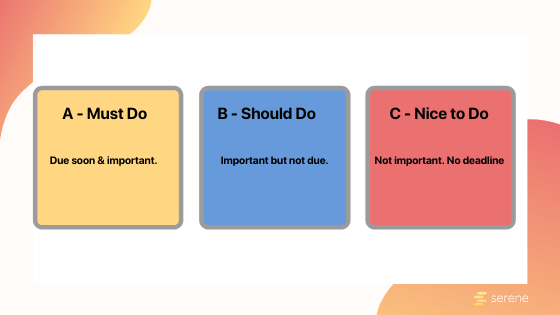
You must start with A and refrain from moving on to B until you finish all of your A tasks. You can also use sub-categories within box A, such as A1, A2, A3, etc.
Day 5 – ABC Method Experiment Results
- Number of words written: 848
- Grammarly score out of 100: Blog post #1: 93, Blog post #2: 81
- Number of article drafts completed: Zero (nothing due today)
- Number of hours worked: 1 hour, 40 minutes
- Words per hour: 508
- Number of Serene sessions completed: 5
- Percentage of tasks completed: 1 out of 3 of the A tasks, 2 out of 5 of the B tasks, and 2 out of 6 of the C tasks
The ABC Method was my least favorite, but it might have been because I didn’t have much energy this day. Instead of following it to a tee, I ended up skipping down to a C task before I completed my A tasks. Because this method dictates that you shouldn’t move to a C task until you finish all of your A and B tasks, it feels inflexible.
6. Time Management Matrix
The following Time Management Matrix is reportedly based on ideas from President Dwight D. Eisenhower and made popular by author Stephen Covey, who wrote about it in his New York Times bestseller, The 7 Habits of Highly Effective People.
To use this time management method, you create a matrix and place your tasks for the day in one of the four quadrants:
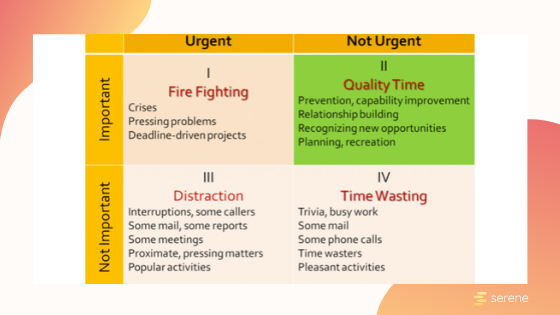
The goal is to spend most of your time in quadrant II (important, but not urgent), as these tasks affect your long-term goals. Quadrant IV is to be avoided whenever possible.
Day 6 – Time Management Matrix Experiment Results
- Number of words written: 821
- Grammarly score out of 100: 98
- Number of article drafts completed: Zero (nothing due)
- Number of hours worked: 2
- Words per hour: 411
- Number of Serene sessions completed: 5
- Percentage of tasks completed: 3 out of 5 in Quadrant I, 1 out of 12 in Quadrant II, 0 out of 1 in Quadrant III, 3 out of 3 in Quadrant IV
I had a hard time with the Time Management Matrix because I was bombarded with so many urgent things on this day. What I liked about it, though, is that it made me realize I am spending the vast majority of my time in quadrants I and IV when I should be spending most of my time in Quadrant II. This shows that I am still being reactive instead of proactive, which is not indicative of someone who has mastered time management.
7. The Pareto Principle (80/20 Rule)
The Pareto Principle stems from the economics world and was created by economist Vilfredo Pareto. But it’s applicable in almost any area. So for time management, the Pareto Principle would assert that 20% of the activities you do each day generate 80% of the results. Or, by decreasing distractions by 20%, you can increase productivity by 80%.
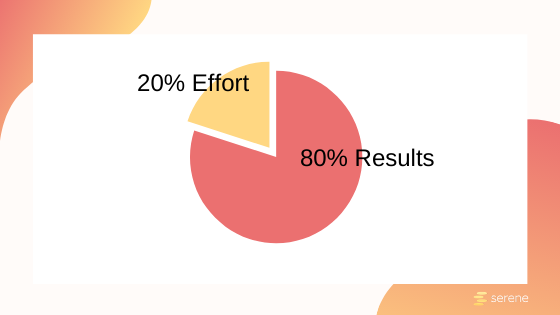
For my experiment, I aimed to reduce my iPhone screen time by 20%, with the expectation that doing so would increase my productivity by 80%.
Day 7 – Pareto Principle Experiment Results
- Number of words written: 985
- Grammarly score out of 100: Blog post #1: 99, Blog post #2: 99
- Number of article drafts completed: 2 (turned one article in a day early)
- Number of hours worked: 4 hours, 30 minutes
- Words per hour: 219
- Number of Serene sessions completed: 10
- Percentage of tasks completed: 3 out of 3 A tasks; 0 out of 5 B tasks
According to my iPhone, on average, I spend 3 hours and 19 minutes a day staring at its screen. For the Pareto experiment, I reduced that to 2 hours 34 minutes, a 23% decrease in screen time. But did that give me an 80% increase in productivity?
Well, I definitely put in more productive work hours today thanks to decreasing my iPhone usage. But if we judge by word count, then I wasn’t as productive as other days in this experiment. On average, I spend about 167 minutes a day doing actual work. Today, I clocked 270 minutes of work. So that means my 23% decrease in iPhone usage yielded a 62% increase in productive work time. Not exactly the 80/20 split I was looking for, but still pretty good!
Which Time Management Theory Will Work for You?
To recap, here are the seven time management theories and methods we covered in this article:
- The Pomodoro Technique
- The Pickle Jar Theory
- Parkinson’s Law
- The ALPEN Method
- The ABC Method
- Time Management Matrix
- The Pareto Principle
So based on my experiment, which of the time management theories and methods were the best? Parkinson’s Law was the clear winner, as it helped me write the most words per hour, produced the highest daily total word count, and got me to complete 100% of my essential tasks for the day.
While applying Parkinson’s Law definitely helped me get more done in one day, it felt stressful as I was constantly trying to beat the clock. Going forward, I plan to continue using the Pomodoro Technique along with Sereneto stay more focused. I’ll also borrow from the ALPEN Method and estimate how long each item on my to-do list will take me.
In the end, which time management theory or method you adhere to depends on personal preference and goals. Go ahead and create your own experiments to see which one works best for you. Here’s to wasting less time!





